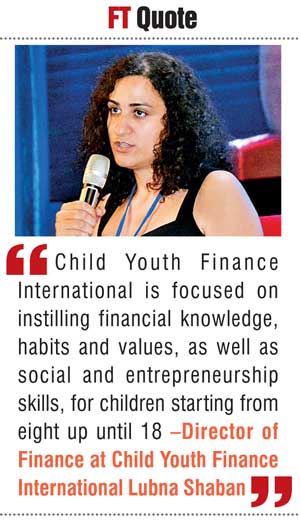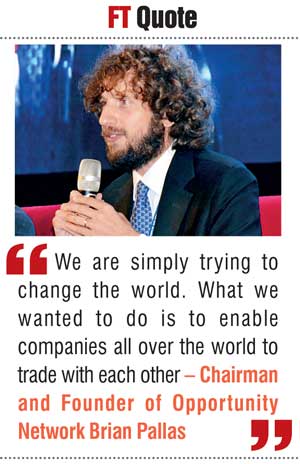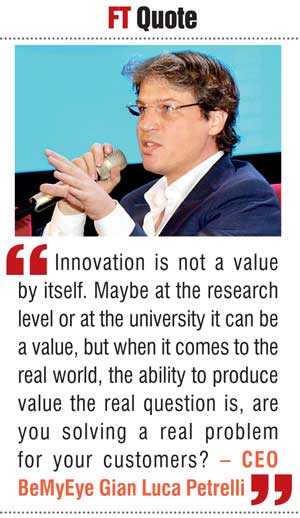Sunday Dec 28, 2025
Sunday Dec 28, 2025
Friday, 14 October 2016 00:01 - - {{hitsCtrl.values.hits}}
By Madushka Balasuriya
Taking an idea from its conception to a fully-fledged successful business is a journey – and at times a prolonged one. While a large portion of the opening day of the World Export Development Forum was dedicated to the macro-economic picture surrounding Sri Lanka’s role as a regional and global hub, the latter part of the day focused on the nuts and bolts of how budding entrepreneurs could execute their ideas successfully.
In a panel discussion titled ‘Young Entrepreneurs Enable Innovation,’ the heads of five diverse and very successful start-ups shared  their (at times opposing) thoughts on how to best push ahead with good ideas, while at the same time overcoming obstacles on the way. Before getting into their thoughts and advice however, here is a brief overview of each company and the people behind them.
their (at times opposing) thoughts on how to best push ahead with good ideas, while at the same time overcoming obstacles on the way. Before getting into their thoughts and advice however, here is a brief overview of each company and the people behind them.
Kapruka
It’s fitting to start with Sri Lanka’s very own success story: Kapruka.com. Since it was formed in 2003, Kapruka has gone on to become Sri Lanka’s largest e-commerce company. What is most notable about this achievement though, is that it was started without any outside investment.
“It is an entirely self-built company, with its own revenues. This is quite rare in the world of e-commerce, because making profits in e-commerce is quite a difficult task,” explained CEO and Founder of Kapruka Dulith Herath.
One of Kapruka’s key innovations, notes Herath, is the Price Checker software which offers 99% accuracy when simulating the hidden costs, such as customs duties and taxes, of ordering from US-based online shops such as Amazon and eBay.
“We simulate and show the customer the estimated cost of the product if they buy it. Then we bring it down and give it to the customer, all the while the customer only has to deal with us.”
The other major innovation is their new door-to-door delivery system dubbed ‘Grasshoppers,’ which makes it possible for anyone with a bike to be a delivery rider for Kapruka. The company is hoping to expand the idea to other countries as well.
Child Youth Finance International
“Child Youth Finance International is focused on instilling financial knowledge, habits and values, as well as social and entrepreneurship skills, for children starting from eight up until 18. While for entrepreneurship we also look at the age group up until 30,” explained Director of Finance at Child Youth Finance International Lubna Shaban.
 Shaban’s department is focused on providing opportunities and support for young entrepreneurs under the age of 30, primarily through an online platform. Entrepreneurs and potential entrepreneurs are encouraged to sign up to a website, which then links them to fellow entrepreneurs, thereby offering a support network. It also links them to mentors and investors wherever possible as well.
Shaban’s department is focused on providing opportunities and support for young entrepreneurs under the age of 30, primarily through an online platform. Entrepreneurs and potential entrepreneurs are encouraged to sign up to a website, which then links them to fellow entrepreneurs, thereby offering a support network. It also links them to mentors and investors wherever possible as well.
“We have around 8,000 registered users on our site from 121 different countries,” she noted.
Opportunity Network
“We are simply trying to change the world,” began Chairman and Founder of Opportunity Network Brian Pallas. “And that is a very modest statement,” he continued, tongue firmly in cheek, before taking on a more serious tone.
“What we wanted to do is to enable companies all over the world to trade with each other. Of course it’s a nice dream, and a few companies have been successful in doing that,” he said pointing to the success of Ali Baba in “mostly” B2C trade in China. Opportunity Network however, Pallas said, was more interested in the B2B side of things on a global scale, which presented a problem.
“If you are 27, like I was at the time, it was very difficult to go door-to-door and ask CEOs of large multinationals if they would like to use my online platform to trade with their peers.” So rather than try to figure out by themselves which companies were the most promising “which is a challenge by itself,” Pallas and his team decided go to enterprises that were already conducting a thorough vetting process of their clients and customers: banks.
“We signed an agreement with banks throughout the globe – in 130 countries now – where each bank invited their clients on to our platform, so that in each country we had the best companies, certified and selected by banks, to do business and trade together,” he explained. “This is impacting the value chain in a way that is more than we could have ever imagined.”
Quicktech
 Quicktech is the company behind EasyShair, an app and web-based service which allows individuals to create and share digital business cards freely and easily.
Quicktech is the company behind EasyShair, an app and web-based service which allows individuals to create and share digital business cards freely and easily.
“The idea really came to me when I was coming back from an event in Africa in 2014,” explained Executive Director and Founder of QuickTech Rhizlan El Alaoui. “When I was coming back from the event I had like 200 business cards, and when I got back to office I realised I had misplaced them. In any case, it was very inconvenient to categorise and keep track of all of them.”
This led to her asking the question we all ask at some point, why isn’t there an easier way to do this? “I wondered why there wasn’t a technological way to avoid using business cards.”
And thus EasyShair was borne. EasyShair at present offers three key services: it allows for the digitalisation of business cards; this information can be exchanged via QR code or other means; but most importantly it offers the ability to network.
“For example, at any event an opportunity might be around the corner but we could miss it simply because we didn’t know that a particular person was at that same event. EasyShair offers real-time information on fellow users at any given place.”
On top of this, the application also provides data on the number of trees saved as a result of not using a traditional paper business card.
BeMyEye
“We are a C2B, yes consumer to business, company,” began Founder and CEO of BeMyEye Gian Luca Petrelli, instantly distinguishing his company from the rest of the pack. “We provide crowd-sourced data from the field to businesses.”
 To be precise, BeMyEye provides businesses with “location-specific information, such as checking in-store promotions and prices, generating sales leads or gathering street level data for mapping enrichment” from a variety of stores across Europe. On the part of the consumer it “gamifies tasks by setting location-specific challenges, enabling people to make money wherever they are, using their smartphones, whenever they wish to work.” These crowd-sourced insights “allow businesses to uncover reliable, real world insights, collected from any location, at scale.”
To be precise, BeMyEye provides businesses with “location-specific information, such as checking in-store promotions and prices, generating sales leads or gathering street level data for mapping enrichment” from a variety of stores across Europe. On the part of the consumer it “gamifies tasks by setting location-specific challenges, enabling people to make money wherever they are, using their smartphones, whenever they wish to work.” These crowd-sourced insights “allow businesses to uncover reliable, real world insights, collected from any location, at scale.”
“At this very moment there are 300,000 people around Europe, who if they look at the app, it will tell them that if they go to a specific supermarket or store and check the prices or presence of a promotion they would earn a couple of euros.”
This allows businesses to “see” thousands of locations within moments, “giving them the intelligence to identify new revenue streams, uphold brand integrity and make savings quickly.”
How to distinguish your company from the rest
With entrepreneurs from such a wide array of industries and backgrounds on the panel, the first question posed to them was of how to distinguish their business in a competitive field. Opportunity Network CEO Brian Pallas said that it depended on what the company’s priorities were – were they looking more local or global?
“The one thing that makes us unique is that we’re the only company worldwide doing it. When Gian Luca talks about BeMyEye I don’t think there’s anyone else doing what he does. So the suggestion is, if you’re going into a crowded market then go local, go niche or go in a way that you can find your competitive advantage, and then expand internationally. But if you are willing and looking to run a global business, it needs to be a monopoly.”
Lubna Shabana however chose to focus more on the importance of innovation as a key differentiating factor, finding it to be the common denominator between the successes of all the individuals taking part in the panel discussion.
“The key is innovation, but it’s important to note there are different types of innovation. When people think of innovation these days, they think of changing the entire world and shifting things on their head – sure that’s innovation but that’s just one type of innovation.
“You can have innovation in the product itself like we’ve seen here, or you can have innovation in the process like we’ve seen in two of your cases, where you’re doing something in a different way with a little twist. And then there’s innovation in the paradigm, which is changing the way something is done by flipping it on its head, which I think our colleague with BeMyEye has done; when you say C2B, you literally flipped it.”
 CEO BeMyEye Gian Luca Petrelli though was quick to warn that innovation on its own wasn’t enough. “Innovation is not a value by itself. Maybe at the research level or at the university it can be a value, but when it comes to the real world, the ability to produce value the real question is, are you solving a real problem for your customers?
CEO BeMyEye Gian Luca Petrelli though was quick to warn that innovation on its own wasn’t enough. “Innovation is not a value by itself. Maybe at the research level or at the university it can be a value, but when it comes to the real world, the ability to produce value the real question is, are you solving a real problem for your customers?
“My suggestion to anyone starting a new business – you hear so often that the team is the best thing or the product is the best – I think the one single thing that is the most important is the fit between the market and your product. If you get the right fit it’s going to be the market that is going to pull your product.
Investment and monetisation
Meanwhile on the topic of drumming up investment the panel was in agreement that money should never be the primary focus of a startup. CEO Kapruka.com Dulith Herath noted that at times a lack of money can even be an added motivator.
“When you walk into the office knowing that you don’t have much money in the bank, it really pressurises you to be more innovative and more efficient.”
Founder of QuickTech Rhizlan El Alaoui added: “Entrepreneurs shouldn’t be constantly on the search for money. Money is the obvious consequence of valuation and of making something meaningful. When we provide a service by improving people’s standards of living, by showing people a better and more efficient way to perform a task, or when we better the world as whole, this gives meaning to what we do.”
Pallas also waded in on the topic, noting: “This question changed a little as it went around, but I think we all agree that money shouldn’t be the main focus. If you have money without a solid idea, it will only ruin the way you run your business, rather than keeping you lean and hungry. The point is not to get the money to build something; it’s to build something, get it right, and then put money behind it.”
On the topic of value creation and the process of monetising it, Herath believed that budding entrepreneurs need to focus on the bottom line “almost from day one”.
“One thing I see at the start of a lot of entrepreneurs is, that they kind of turn a blind eye on the finance part. You need to be very focused on remuneration and see if you’re creating net profit almost from day one.”
Pallas meanwhile took a broader stance, stating that if you create a profitable enough value chain then even taking a small portion of it would be enough. “Each player in the chain should be getting value. Once you have enough value for them, as long as you can get a small piece of that it should be good enough. In our case, in year one we were highly profitable, but still we were taking less than 1% from the value that we were generating for our clients.
“In my mind, don’t focus on capturing a piece of the value, but focus on capturing enough value to so that if you take a small piece if it nobody will really mind, because you’re creating so much more for everyone else.”
Disrupting disruption: Create a positive impact
Disruption has been a buzz word for entrepreneurs for a while now, with the success of companies like Uber and AirBnB opening the eyes of startups the world over on the possibilities of becoming the next big disruptor in almost any industry. But Pallas is not a fan, going as far as to urge new startups to avoid disrupting industries, and to instead work within them to help the overall growth of your respective countries.
“When you start something new and disruptive, you are coming into a value chain, killing the dinosaur and replacing it with yourself. That’s more efficient for the consumer but you’re still putting people out of jobs and closing down companies. And the total GDP effect is also negative. So in other words, the value you create for your end user is positive, but the value you create for the economy is negative.
“When you do that in the short run, when you’re still running a small business, you’re ok because nobody really cares. But the more you grow, the more the ones that you’re trying to get out of business will fight back. Uber is not in a lot of countries because taxi drivers, who not really the most organised force around the globe, are fighting back. Policymakers and big multinationals will also fight against you. Whoever you’re displacing, whoever you’re damaging – at a certain point when you’re big enough – will come at you and try to kill you or regulate you, which is the same thing most times.”
Pallas suggest digital symbiosis over disruption, stating: “This means you get in the value chain and try to add value for each piece of that chain including the external secularised governments rather than displacing value. And I feel that in our generation the ability to create a positive impact on the whole system is something that is key.”
Adapting to your environment
One final key issue discussed was the necessity for entrepreneurs and startups to know and adapt to their respective markets. Lubna Shaban who works with several young entrepreneurs felt that while the process was the same for most, external factors did play a role.
“The process is quite similar, but what does affect is the external factors, such as the political situation in a country or the entrepreneurship ecosystem. Is the market ready for such an innovation? Some countries are sometimes more open for technological innovation than others.”
Herath meanwhile used Kapruka as an example of turning the lack of certain facilities in a country into an opportunity. “There are a lot of deficiencies in a country that can be seen as opportunities to create a solution. Regulations in Sri Lanka mean that it is difficult to order directly from Amazon and eBay, so that created a gap in the market for us to capitalise on. I can’t do this in Europe or developed countries, I can only do this here.”
El Alaoui felt that regardless of which market or environment you’re in, one principle stood tall above all: Listen to the market, as it will guide your product. “After reaching a certain stage in the products market development, there comes a cooperation between the market and the business. We don’t develop the product anymore by ourselves, we develop it according to the market needs. You need to listen to the consumers’ feedback.”
This was a point built on by Petrelli, who urged startups not to dwell too much on perfecting a product but to get it out there fast and let the market do the rest.
“Don’t try to do three, four, five things. Don’t do too many features, because maybe your customer might not even want some of them. Do just one thing, and get to the market as soon as you can and try to validate that.”
Pix by Upul Abayasekara